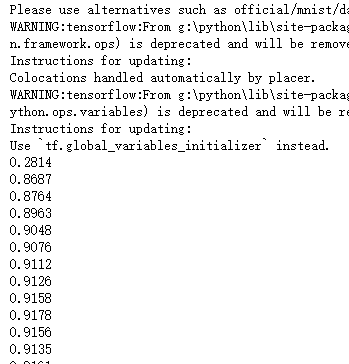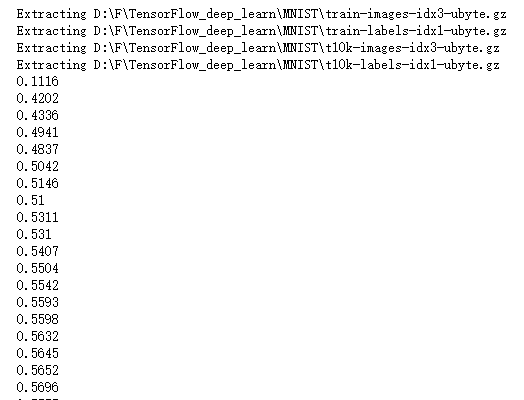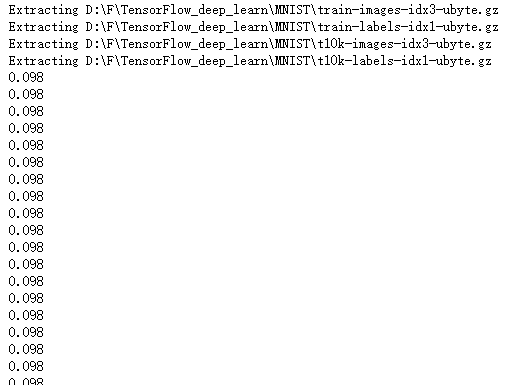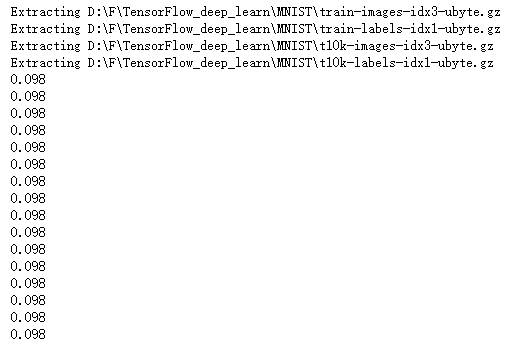import tensorflow as tf import tensorflow.examples.tutorials.mnist.input_data as input_data mnist = input_data.read_data_sets("D:\F\TensorFlow_deep_learn\MNIST\", one_hot=True) x_data = tf.placeholder("float32", [None, 784]) weight = tf.Variable(tf.ones([784, 10])) bias = tf.Variable(tf.ones([10])) y_model = tf.nn.softmax(tf.matmul(x_data, weight) + bias) y_data = tf.placeholder("float32", [None, 10]) loss = tf.reduce_sum(tf.pow((y_model - y_data), 2)) train_step = tf.train.GradientDescentOptimizer(0.01).minimize(loss) init = tf.initialize_all_variables() sess = tf.Session() sess.run(init) for _ in range(1000): batch_xs, batch_ys = mnist.train.next_batch(100) sess.run(train_step, feed_dict={x_data:batch_xs, y_data:batch_ys}) if _ % 50 == 0: correct_prediction = tf.equal(tf.argmax(y_model, 1), tf.argmax(y_data, 1)) accuracy = tf.reduce_mean(tf.cast(correct_prediction, "float")) print(sess.run(accuracy, feed_dict={x_data: mnist.test.images, y_data: mnist.test.labels}))

import tensorflow as tf import tensorflow.examples.tutorials.mnist.input_data as input_data mnist = input_data.read_data_sets("D:\F\TensorFlow_deep_learn\MNIST\", one_hot=True) x_data = tf.placeholder("float32", [None, 784]) weight = tf.Variable(tf.ones([784, 10])) bias = tf.Variable(tf.ones([10])) y_model = tf.nn.relu(tf.matmul(x_data, weight) + bias) y_data = tf.placeholder("float32", [None, 10]) loss = -tf.reduce_sum(y_data*tf.log(y_model)) train_step = tf.train.GradientDescentOptimizer(0.01).minimize(loss) init = tf.initialize_all_variables() sess = tf.Session() sess.run(init) for _ in range(1000): batch_xs, batch_ys = mnist.train.next_batch(50) sess.run(train_step, feed_dict={x_data:batch_xs, y_data:batch_ys}) if _ % 50 == 0: correct_prediction = tf.equal(tf.argmax(y_model, 1), tf.argmax(y_data, 1)) accuracy = tf.reduce_mean(tf.cast(correct_prediction, "float")) print(sess.run(accuracy, feed_dict={x_data: mnist.test.images, y_data: mnist.test.labels}))

import tensorflow as tf import tensorflow.examples.tutorials.mnist.input_data as input_data mnist = input_data.read_data_sets("D:\F\TensorFlow_deep_learn\MNIST\", one_hot=True) x_data = tf.placeholder("float32", [None, 784]) weight1 = tf.Variable(tf.ones([784, 256])) bias1 = tf.Variable(tf.ones([256])) y1_model1 = tf.matmul(x_data, weight1) + bias1 weight2 = tf.Variable(tf.ones([256, 10])) bias2 = tf.Variable(tf.ones([10])) y_model = tf.nn.softmax(tf.matmul(y1_model1, weight2) + bias2) y_data = tf.placeholder("float32", [None, 10]) loss = -tf.reduce_sum(y_data*tf.log(y_model)) train_step = tf.train.GradientDescentOptimizer(0.01).minimize(loss) init = tf.initialize_all_variables() sess = tf.Session() sess.run(init) for _ in range(1000): batch_xs, batch_ys = mnist.train.next_batch(50) sess.run(train_step, feed_dict={x_data:batch_xs, y_data:batch_ys}) if _ % 50 == 0: correct_prediction = tf.equal(tf.argmax(y_model, 1), tf.argmax(y_data, 1)) accuracy = tf.reduce_mean(tf.cast(correct_prediction, "float")) print(sess.run(accuracy, feed_dict={x_data: mnist.test.images, y_data: mnist.test.labels}))

import tensorflow as tf import tensorflow.examples.tutorials.mnist.input_data as input_data mnist = input_data.read_data_sets("D:\F\TensorFlow_deep_learn\MNIST\", one_hot=True) x_data = tf.placeholder("float32", [None, 784]) x_image = tf.reshape(x_data, [-1,28,28,1]) w_conv = tf.Variable(tf.ones([5,5,1,32])) b_conv = tf.Variable(tf.ones([32])) h_conv = tf.nn.relu(tf.nn.conv2d(x_image, w_conv, strides=[1, 1, 1, 1], padding='SAME') + b_conv) h_pool = tf.nn.max_pool(h_conv, ksize=[1, 2, 2, 1],strides=[1, 2, 2, 1], padding='SAME') w_fc = tf.Variable(tf.ones([14*14*32,1024])) b_fc = tf.Variable(tf.ones([1024])) h_pool_flat = tf.reshape(h_pool, [-1, 14*14*32]) h_fc = tf.nn.relu(tf.matmul(h_pool_flat, w_fc) + b_fc) W_fc2 = tf.Variable(tf.ones([1024,10])) b_fc2 = tf.Variable(tf.ones([10])) y_model = tf.nn.softmax(tf.matmul(h_fc, W_fc2) + b_fc2) y_data = tf.placeholder("float32", [None, 10]) loss = -tf.reduce_sum(y_data*tf.log(y_model)) train_step = tf.train.GradientDescentOptimizer(0.01).minimize(loss) init = tf.initialize_all_variables() sess = tf.Session() sess.run(init) for _ in range(1000): batch_xs, batch_ys = mnist.train.next_batch(200) sess.run(train_step, feed_dict={x_data:batch_xs, y_data:batch_ys}) if _ % 50 == 0: correct_prediction = tf.equal(tf.argmax(y_model, 1), tf.argmax(y_data, 1)) accuracy = tf.reduce_mean(tf.cast(correct_prediction, "float")) print(sess.run(accuracy, feed_dict={x_data: mnist.test.images, y_data: mnist.test.labels}))

import tensorflow as tf import tensorflow.examples.tutorials.mnist.input_data as input_data mnist = input_data.read_data_sets("D:\F\TensorFlow_deep_learn\MNIST\", one_hot=True) x_data = tf.placeholder("float", shape=[None, 784]) y_data = tf.placeholder("float", shape=[None, 10]) def weight_variable(shape): initial = tf.truncated_normal(shape, stddev=0.1) return tf.Variable(initial) def bias_variable(shape): initial = tf.constant(0.1, shape=shape) return tf.Variable(initial) def conv2d(x, W): return tf.nn.conv2d(x, W, strides=[1, 1, 1, 1], padding='VALID') def max_pool_2x2(x): return tf.nn.max_pool(x, ksize=[1, 2, 2, 1], strides=[1, 2, 2, 1], padding='VALID') W_conv1 = weight_variable([5, 5, 1, 32]) b_conv1 = bias_variable([32]) x_image = tf.reshape(x_data, [-1, 28, 28, 1]) h_conv1 = tf.nn.relu(conv2d(x_image, W_conv1) + b_conv1) h_pool1 = max_pool_2x2(h_conv1) W_conv2 = weight_variable([5, 5, 32, 64]) b_conv2 = bias_variable([64]) h_conv2 = tf.nn.relu(conv2d(h_pool1, W_conv2) + b_conv2) h_pool2 = max_pool_2x2(h_conv2) W_fc1 = weight_variable([4 * 4 * 64, 1024]) b_fc1 = bias_variable([1024]) h_pool2_flat = tf.reshape(h_pool2, [-1, 4*4*64]) h_fc1 = tf.nn.relu(tf.matmul(h_pool2_flat, W_fc1) + b_fc1) keep_prob = tf.placeholder("float") h_fc1_drop = tf.nn.dropout(h_fc1, keep_prob) W_fc2 = weight_variable([1024, 10]) b_fc2 = bias_variable([10]) y_conv=tf.nn.softmax(tf.matmul(h_fc1_drop, W_fc2) + b_fc2) cross_entropy = -tf.reduce_sum(y_data * tf.log(y_conv)) train_step = tf.train.AdamOptimizer(1e-2).minimize(cross_entropy) correct_prediction = tf.equal(tf.argmax(y_conv,1), tf.argmax(y_data, 1)) accuracy = tf.reduce_mean(tf.cast(correct_prediction, "float")) sess = tf.Session() sess.run(tf.initialize_all_variables()) for i in range(1000): batch = mnist.train.next_batch(50) if i%5 == 0: train_accuracy = sess.run(accuracy, feed_dict={x_data:batch[0], y_data: batch[1], keep_prob: 1.0}) print("step %d, training accuracy %g"%(i, train_accuracy)) sess.run(train_step, feed_dict={x_data: batch[0], y_data: batch[1], keep_prob: 0.5})
